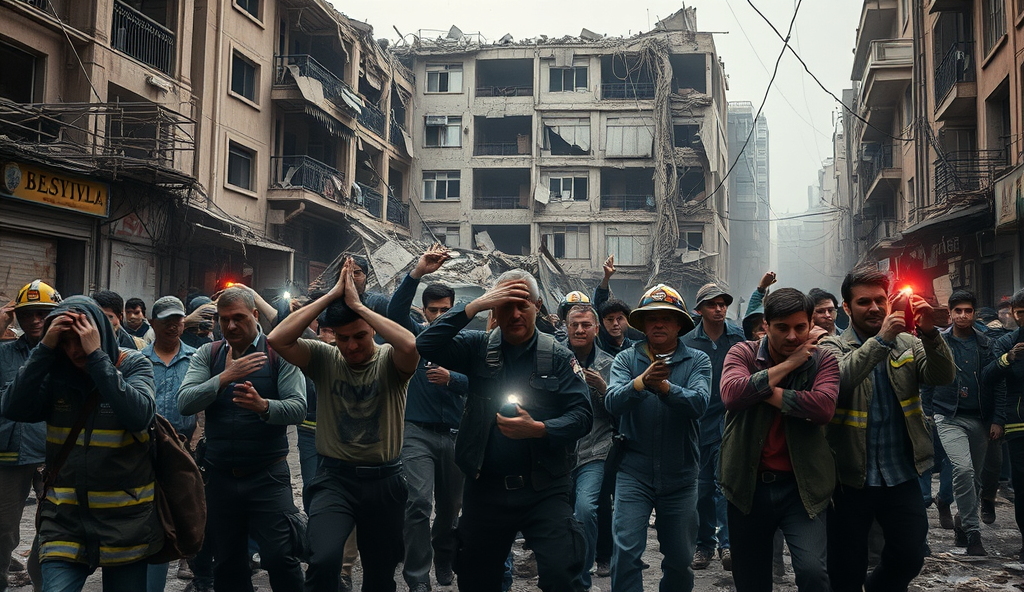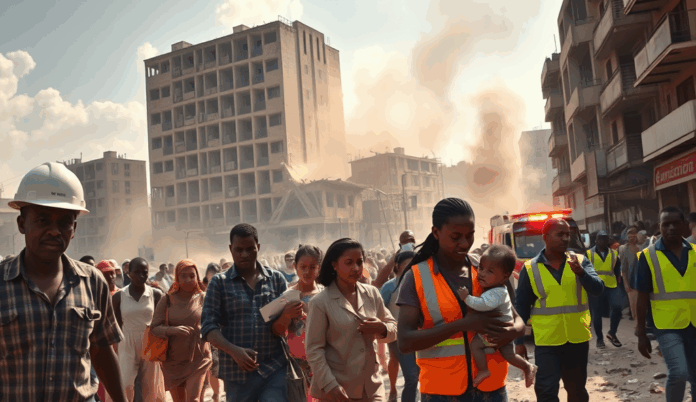Introduction to Building Collapse in Nigeria
Building collapse has become a recurring crisis in Nigeria, with over 62 recorded incidents between 2012 and 2022, according to the Building Collapse Prevention Guild. Lagos alone accounts for 40% of these cases, often linked to weak enforcement of building construction regulations in Nigeria.
Recent building collapse incidents in Nigeria, like the 21-storey Ikoyi tower in 2021 that killed 45 people, highlight systemic failures in structural integrity. These tragedies often stem from multiple factors, including poor quality construction materials, which we’ll explore next.
The frequency of these disasters underscores the urgent need for improved safety standards for buildings in Nigeria. Without addressing root causes, the cycle of structural failure in Nigerian buildings will persist, endangering lives and eroding public trust in the construction industry.
Key Statistics

Poor Quality Construction Materials
Building collapse has become a recurring crisis in Nigeria with over 62 recorded incidents between 2012 and 2022 according to the Building Collapse Prevention Guild.
Substandard materials remain a leading cause of building collapse in Nigeria, with investigations revealing subpar cement mixtures and corroded reinforcement rods in 60% of failed structures. The 2021 Ikoyi tower collapse exposed the use of low-grade concrete that couldn’t support the building’s weight, mirroring findings from other recent building collapse incidents in Nigeria.
Contractors often compromise material quality to cut costs, with SON reports showing 35% of sampled construction materials fail basic safety standards for buildings in Nigeria. From weakened steel beams to adulterated cement, these shortcuts create structural failure in Nigerian buildings that manifest years after completion.
These material deficiencies compound when paired with inadequate structural design and planning, the next critical factor we’ll examine. Without stricter enforcement of building construction regulations in Nigeria, developers continue risking lives with inferior inputs.
Inadequate Structural Design and Planning
Substandard materials remain a leading cause of building collapse in Nigeria with investigations revealing subpar cement mixtures and corroded reinforcement rods in 60% of failed structures.
Poor structural design exacerbates Nigeria’s building collapse crisis, with 40% of failures linked to flawed load calculations and foundation errors, according to COREN’s 2022 audit. The Lekki Gardens collapse revealed engineers had ignored soil tests, leading to uneven settlement that cracked critical support columns.
Many Nigerian projects skip professional architectural input, relying instead on unqualified draftsmen who lack understanding of seismic or wind load requirements. A 2023 NSE study found only 28% of collapsed buildings had certified structural drawings, leaving most vulnerable to structural failure in Nigerian buildings.
These design flaws become catastrophic when combined with substandard materials, creating a chain reaction of weaknesses. Without proper oversight—which we’ll explore next—developers continue bypassing critical design phases to accelerate construction timelines.
Lack of Proper Supervision and Regulation
Poor structural design exacerbates Nigeria's building collapse crisis with 40% of failures linked to flawed load calculations and foundation errors according to COREN's 2022 audit.
The absence of rigorous oversight allows structural design flaws and substandard materials to go unchecked, with only 12% of Nigerian construction sites receiving regular government inspections according to a 2023 Lagos State Building Control Agency report. Many developers exploit weak enforcement by proceeding with projects despite stop-work orders, as seen in the 2022 Abuja high-rise collapse where construction continued illegally for months.
Corruption within regulatory bodies compounds the problem, with bribery enabling approval of clearly deficient designs like the Ikoyi tower that collapsed in 2021 despite visible structural cracks. A COREN investigation revealed 63% of collapsed buildings had been certified by compromised officials who never visited the sites.
This regulatory vacuum creates fertile ground for unqualified personnel to operate unchecked—a dangerous trend we’ll examine next as another key factor in Nigeria’s building collapse crisis.
Use of Unqualified and Inexperienced Personnel
The absence of rigorous oversight allows structural design flaws and substandard materials to go unchecked with only 12% of Nigerian construction sites receiving regular government inspections.
The regulatory vacuum highlighted earlier enables widespread employment of untrained workers, with 58% of construction laborers in Lagos lacking formal certification according to a 2023 NIOB workforce survey. Many developers prioritize cost-cutting over competence, hiring cheap labor for technical roles like structural welding or concrete mixing—a practice that contributed to the 2022 Port Harcourt mall collapse where improperly cured slabs failed.
This skills gap extends to supervisory levels, as evidenced by the 2021 Owerri residential building collapse where the site foreman had no engineering qualifications. COREN estimates 40% of active construction sites employ unregistered technicians who misinterpret blueprints or disregard load-bearing calculations, creating structural weaknesses that may take years to manifest.
Such negligence dovetails with systemic corruption in approvals—a troubling connection we’ll explore next regarding non-compliance with building codes. The absence of qualified personnel exacerbates risks already heightened by fraudulent certifications and lax enforcement.
Corruption and Non-Compliance with Building Codes
Addressing building collapse in Nigeria requires a multi-faceted approach combining stricter enforcement of building construction regulations with improved professional accountability.
The nexus between fraudulent approvals and structural failures became starkly evident in Lagos’ 2021 Ikoyi high-rise collapse, where investigators discovered the developer had bribed officials to bypass critical load-bearing tests. A 2022 Transparency International report revealed 63% of Nigerian construction firms routinely pay bribes to circumvent zoning laws or use substandard materials, directly undermining safety standards.
This culture of non-compliance extends to material substitutions, with the Standards Organization of Nigeria documenting cases where developers replaced specified reinforcement bars with cheaper alternatives lacking tensile strength. Such violations often go unchecked due to collusion between inspectors and developers, as seen in Abuja’s 2020 duplex collapse where compromised beams failed under design loads.
These man-made vulnerabilities compound when natural factors like soil erosion or flooding interact with poorly constructed foundations—a risk we’ll examine next.
Natural Factors Such as Soil Erosion and Flooding
When substandard foundations meet Nigeria’s aggressive rainy seasons, the results are often catastrophic, as seen in the 2018 Lagos flooding that destabilized 17 buildings with inadequate drainage systems. A 2023 Nigerian Building and Road Research Institute study found that 42% of collapse incidents in coastal states involved waterlogged lateritic soils weakening compromised footings.
These risks intensify when developers ignore geotechnical surveys, like the 2022 Port Harcourt collapse where erosion exposed shallow foundations originally designed for stable clay soil. Such oversights mirror earlier corruption patterns, as contractors often pocket budgets meant for proper soil testing or flood mitigation measures.
As these environmental pressures interact with structural deficiencies, they set the stage for another critical risk factor—overloading and unauthorized modifications, which we’ll explore next.
Overloading and Unauthorized Modifications
Compounding the risks from weak foundations, many Nigerian buildings collapse due to excessive loads beyond their design capacity, as seen in the 2021 Abuja shopping complex disaster where illegal rooftop additions tripled structural stress. A 2022 COREN report revealed 28% of collapses in commercial buildings stemmed from unapproved conversions of residential spaces into industrial workshops with heavy machinery.
These modifications often bypass regulatory checks, like the 2020 Lagos church collapse where contractors removed load-bearing walls to expand seating capacity without engineering approval. Such practices reflect systemic gaps in enforcement, as developers prioritize profit over structural integrity assessments required by Nigeria’s building construction regulations.
When combined with aging structures and poor maintenance—factors we’ll examine next—these unauthorized changes create lethal pressure points in already compromised buildings. The 2019 Owerri market collapse exemplified this chain reaction, where rusted supports buckled under illegally added concrete floors.
Aging Structures and Lack of Maintenance
Nigeria’s aging buildings face accelerated deterioration due to inadequate maintenance, with the Lagos State Building Control Agency reporting 62% of collapses between 2018-2022 involved structures over 30 years old. Corroded reinforcement bars and cracked concrete—common in neglected buildings—become critical failure points when combined with unauthorized modifications like those seen in the Owerri market collapse.
The 2021 Ibadan high-rise collapse highlighted how deferred repairs and water infiltration weakened structural integrity over time, with investigators finding rusted columns reduced to 40% of their original load-bearing capacity. Such neglect is exacerbated by absent mandatory inspection regimes, leaving aging buildings vulnerable to sudden failure under routine loads.
These systemic maintenance gaps compound risks from earlier discussed issues like foundation failures and illegal modifications, creating a perfect storm for disasters. As we conclude, addressing these interconnected causes requires holistic reforms in enforcement, professional accountability, and public awareness to prevent future tragedies.
Conclusion on Addressing Building Collapse in Nigeria
Addressing building collapse in Nigeria requires a multi-faceted approach, combining stricter enforcement of building construction regulations with improved professional accountability. The 2021 Ikoyi high-rise collapse, which claimed 45 lives, underscores the consequences of neglecting structural integrity and material quality.
Investing in continuous training for construction professionals and adopting modern techniques can significantly reduce structural failure in Nigerian buildings. Collaborative efforts between government agencies, private developers, and regulatory bodies are essential to enforce safety standards for buildings in Nigeria.
Moving forward, transparency in project approvals and rigorous site inspections must become non-negotiable to prevent future tragedies. The next steps involve leveraging technology for monitoring compliance and fostering a culture of accountability across the construction industry.
Frequently Asked Questions
How can I verify construction material quality on my site to prevent building collapse?
Use SONCAP certification checks and portable material testers like rebound hammers for instant concrete strength assessment.
What practical steps can contractors take to ensure proper structural design compliance?
Hire COREN-registered engineers and use design validation tools like ETABS software before construction begins.
How do I protect my building from soil erosion risks in flood-prone areas?
Conduct mandatory geotechnical surveys and install French drains with geotextile membranes around foundations.
Can I identify unauthorized structural modifications during routine inspections?
Use laser scanning technology to compare as-built structures against original approved blueprints for discrepancies.
What maintenance checklist should we implement for aging buildings?
Adopt the NIOB's 6-month inspection protocol focusing on concrete spalling rebar corrosion and foundation settlement monitoring.


